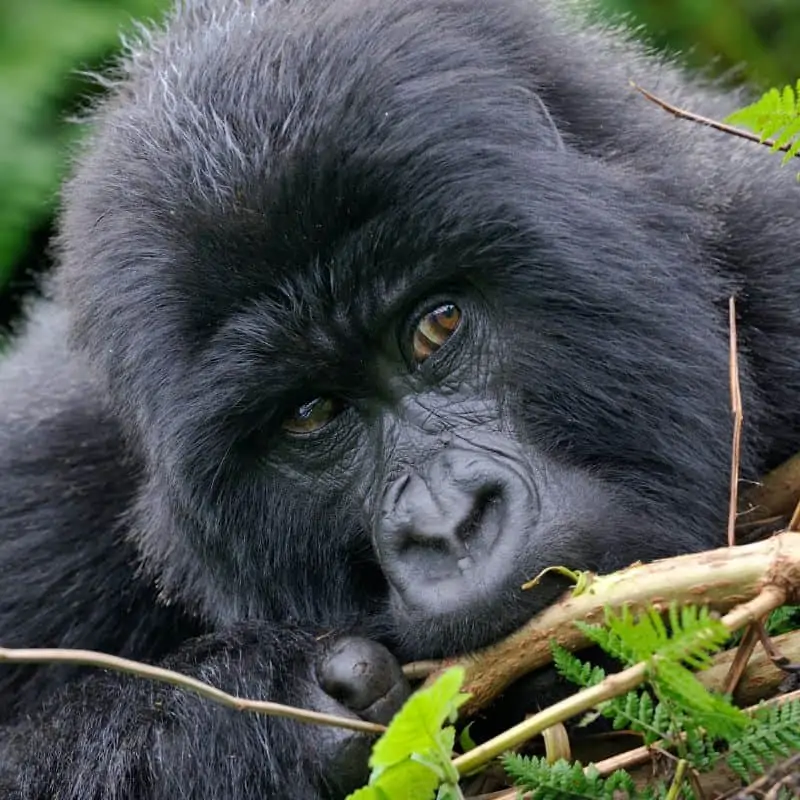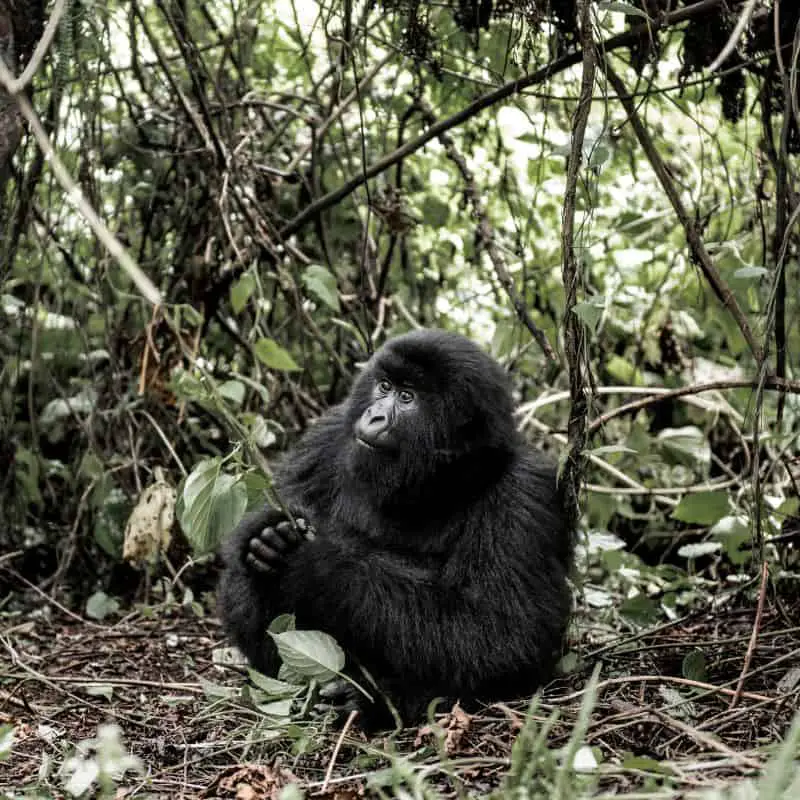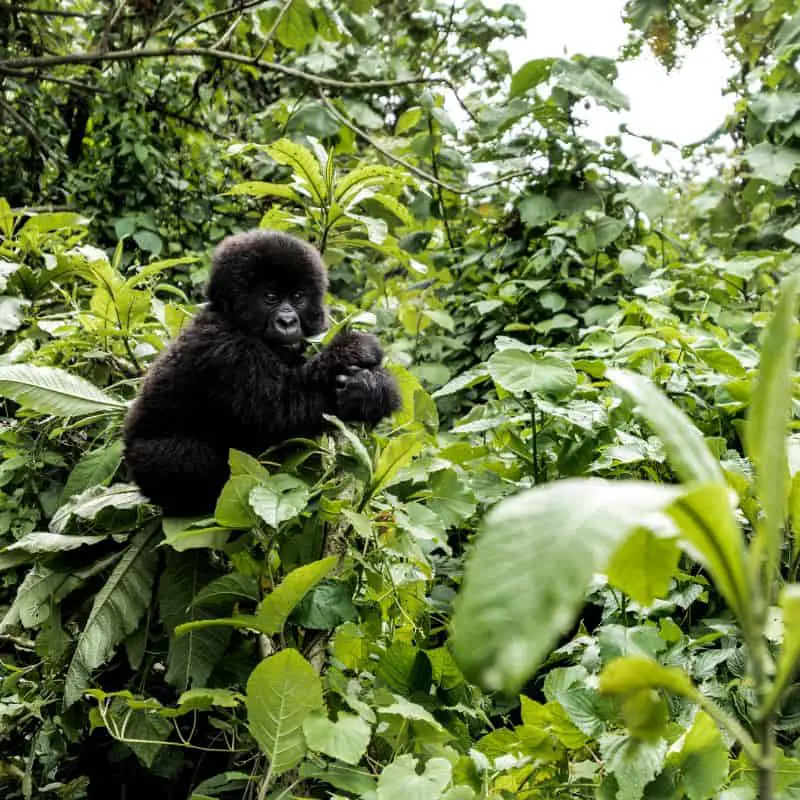Most mountain gorillas inhabit the mountainous areas of the Democratic Republic of Congo, Rwanda, and Uganda. These countries are called home by half of the world’s gorilla population. The Congo mountain gorilla is a subspecies of the Gorilla beringei, also known as the eastern gorillas.
The Congo Mountain gorillas are a subspecies of the Gorilla beringei and are critically endangered. Humans share ninety-eight percent of their DNA with gorillas. Mountain gorillas live in family groups high up mountain ranges in central Africa.
Congo mountain gorillas live in the Virunga Mountains range that borders the Democratic Republic of Congo, Uganda, and Rwanda on the African continent.

- Physical appearance of Congo Mountain Gorillas
- How intelligent are Congo Mountain Gorillas?
- How long do Mountain Gorillas live?
- What do Congo Mountain Gorillas eat?
- Where do Congo Mountain Gorillas live?
- Congo Mountain Gorilla family life
- Why are Congo Mountain Gorillas special?
- Are Congo Mountain Gorillas in danger of extinction?
- Final thoughts on the Congo Mountain Gorillas
Physical appearance of Congo Mountain Gorillas
The Congo Mountain gorillas have shorter arms than their eastern lowland gorilla family but have longer teeth, jaws, and hair than them.
Baby gorillas start small, weighing a mere four pounds at birth. However, the average weight for an adult mountain gorilla is three hundred and fifty-three pounds, while adult females may tip the scale at one hundred and ninety-nine pounds. As a result, mountain gorillas can grow between four to six feet tall, making them the world’s largest primates.
Adult male mountain gorillas are referred to as “Silverbacks” since they grow silver-gray hair on their hips and back, distinguishing them from juvenile and female gorillas.
A healthy silverback gorilla is powerful and can lift and throw objects weighing up to one thousand eight hundred pounds. Gorillas have strong arms and grips due to moving on all fours when searching for food. In addition, they bite with more force than lions, crocodiles, and other carnivores.
Despite their strength, mountain gorillas only display their power when they protect their family group. Mountain gorillas are gentle and docile creatures that only show force when provoked.
How intelligent are Congo Mountain Gorillas?
Since gorillas share as much as ninety-eight percent of DNA with humans, they are extremely clever. Researchers and guides have found that gorillas can solve problems they encounter in nature much the same way humans would.
Guides have recorded juvenile gorillas using sticks to measure the depth of a hole, using sticks to catch ants for lunch, and witnessed silverbacks helping juvenile and female gorillas cross rivers.
Gorillas can learn sign language, which is further proof of their intelligence.
How long do Mountain Gorillas live?
Healthy Congo Mountain gorillas can live to be thirty-five to forty years old and, in captivity, may reach the ripe old age of fifty.
Leopards and crocodiles are the only predators that will hunt gorillas and focus on catching young, ill, or lone gorillas. However, the biggest threat to the mountain gorilla’s survival is humans.
What do Congo Mountain Gorillas eat?

Congo mountain gorillas are vegetarians and live off fruit, stems, and bamboo shoots. Adult gorillas need to eat about sixty pounds daily to maintain their big bodies.
They mainly eat during the morning and late afternoons, and take time out during the warmest parts of the day, lazing around, grooming, and playing with the young gorillas.
To ensure that every member of the group gets enough food, gorillas are constantly on the move searching for food. Even though they prefer their vegetarian diet, they will occasionally consume meat in the form of small animals.
The moisture in the fruit, plant stems, and bamboo shoots that gorillas eat is enough to sustain them when water is scarce. Bamboo shoots consist of eighty-five percent water, enough to keep gorillas hydrated.
Where do Congo Mountain Gorillas live?
A large group of Congo Mountain gorillas lives high up in the Virunga mountains that border the Democratic Republic of Congo. Uganda and Rwanda.
They live at altitudes of eight thousand to thirteen thousand feet above sea level, resulting in temperatures falling below freezing. Their long, thick fur protects them from the cold.
Their unfortunate encounters with humans have driven these gorillas to move further up the mountains for extended periods, exposing them to dangerous and often deadly circumstances.
Once again, confirming that the greatest threat to mountain gorillas is human beings.

Congo Mountain Gorilla family life
These gorillas live in family groups. Family groups consist of a silverback which is the leader, three to four adult females, and numerous young and baby gorillas. The silverback mate with all the adult females, and the group’s offspring are all his.
Female gorillas may raise between two and six gorillas in their lifetime since gorilla infants’ mortality rate is around forty percent. In addition, female gorillas rarely give birth to twins.
A female gorilla carries her baby for nine months before giving birth to a four-pound bundle of joy. They are excellent mothers, protecting their babies from danger, teaching them everything they need to survive, and caring for them until they turn four, and can operate independently from their mother. Juvenile gorillas learn about being parents themselves by keeping an eye on their younger siblings.
The male gorillas are very protective of their family group and will protect them with vigor and strength.
Male gorillas usually leave the group searching or forming their group shortly after they mature. They form their family group by stealing away females from other males, mating with them, and producing their offspring. The females that carried his babies will stay with his group.
Female gorillas may leave their family group to join another to prevent inbreeding, and research has shown that females may join separate groups throughout their life.
Researchers have recorded family groups varying in size from two gorillas up to groups consisting of sixty-five gorillas. Gorillas are very family orientated and grieve their dead. New mothers may carry their dead baby for weeks, too emotional to let it go.

Why are Congo Mountain Gorillas special?
An estimated third of the world’s mountain gorillas live in the Virunga mountains. These mountains are rich in resources and the perfect habitat for mountain gorillas. Besides oil and gold, the much less abundant mountain gorilla is the Congo’s most treasured possession. Unfortunately, this treasure is under immense threat of becoming extinct.
Mountain gorillas live off plant stems, bamboo shoots, and fruits. The Virunga mountain region provides one-hundred and forty varieties of shoots, plants, stems, and fruit to sustain these majestic animals.
There are only one thousand gorillas left living in the Virunga mountains. However, these animals may become extinct within a few years without the necessary conservation efforts.
Are Congo Mountain Gorillas in danger of extinction?
Congo mountain gorillas are a critically endangered species. Their numbers have dwindled due to the following factors. First, as mentioned earlier in this article, humans pose the biggest threat to gorillas.
- Illegal charcoal making is a multi-million-dollar industry in the Virunga mountains. This practice clears and destroys the forest diminishing the gorilla’s natural habitat.
- Inhabitants set traps to catch other smaller animals. Gorillas get caught in these traps and endure severe injuries or death.
- Humans clear forests for agricultural and livestock purposes, taking away more of the gorilla’s habitat.
- Gorillas have no natural defense against human diseases. The common cold can kill a gorilla; the more humans and gorillas interact, the more gorillas die of these diseases.
Fortunately, conservationists and national parks run various programs to ensure the survival of these precious animals.
Final thoughts on the Congo Mountain Gorillas
The mountain gorillas living in the Virunga mountains are critically endangered. Fortunately, there are various programs run by conservationists and national parks to ensure their survival.
Eco-tourists enjoy gorilla trekking expeditions in the Congo. Gorilla trekking provides encounters with groups of Congo Mountain Gorillas.
These treks help support conservation efforts and get subsidized with the money gathered from tourists and support researchers, field guards, sanctuaries, and rehabilitation centers.
